Looking for a Toggl vs RescueTime comparison?
With businesses more competitive than ever before, it’s critical to know where your employees spend their work hours.
Fortunately, time tracking and productivity apps can help you out there.
They allow you to keep a tab on your team’s productivity, giving you insights on how your team spends their time, and helps optimize your business workflow.
However, there are hundreds of these apps available online.
Many of them have almost similar features and accomplish the same task.
So how do you know which software to choose?
In this article, we’ll help you answer that question by comparing the features and pricing of two time tracking tools: Toggl Track and RescueTime. We’ll also give you a powerful alternative that can boost your productivity.

Table of Contents
- What is Toggl Track?
- What is RescueTime?
- Toggl Track vs. RescueTime comparison
- A powerful alternative to RescueTime and Toggl
- Toggl Vs RescueTime: Final verdict
Let’s get started.
What is Toggl Track?
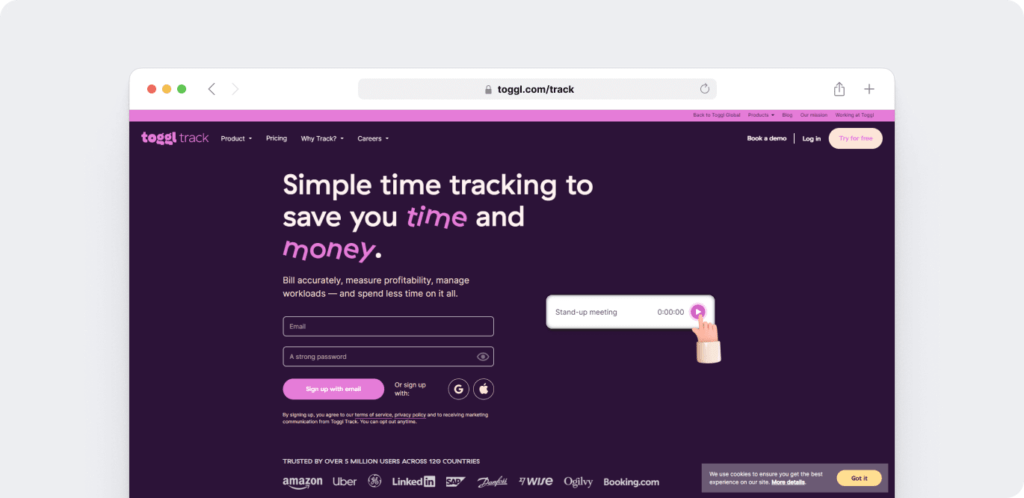
Toggl Track is a time tracking app and productivity management software that keeps a log of the time you spent on every different app and website. Its primary focus is on time and revenue tracking.
Whether you have a small team or a freelancer, Toggl gives you an accurate idea of how to boost productivity.
With Toggl Track, you can:
- Identify where your team members are spending their time.
- Manage your projects and track progress.
- Calculate the idle time of your employees.
- Streamline work hours to make your team more productive, etc.
What is RescueTime?
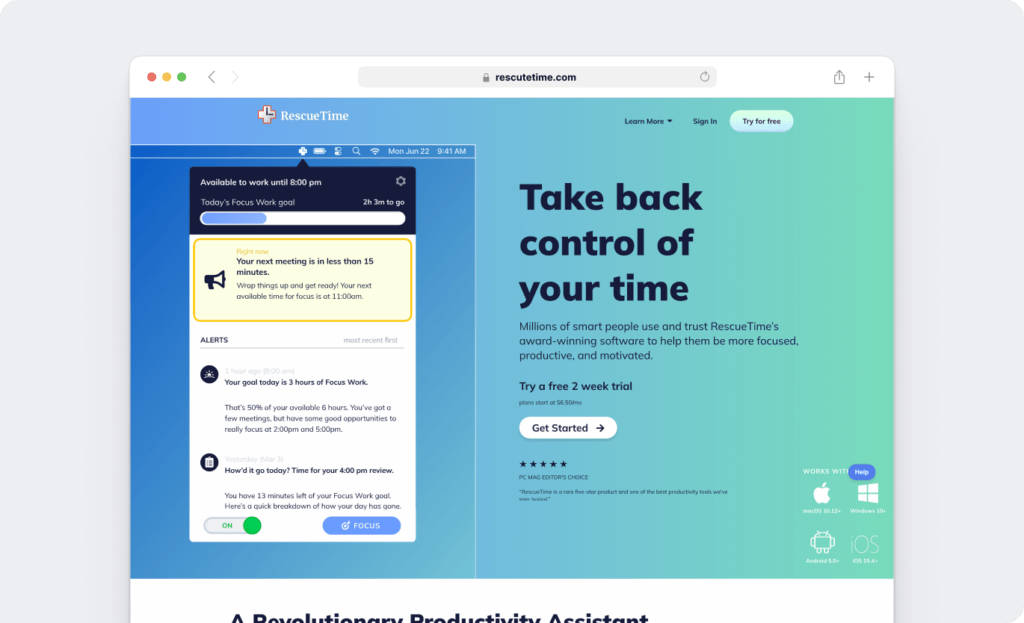
Like Toggl Track, RescueTime is also a time and productivity tracking app.
However, it focuses more on how your team spends their time throughout the day against time spent on a project-by-project basis in Toggl Track.
With RescueTime, you can:
- View time spent on websites and apps.
- Visualize your productivity data in graphs and diagrams.
- Have on-screen alerts to help you focus on the task at hand.
- Block distracting websites to focus on productive tasks, etc.
Toggl Track vs. RescueTime comparison
Now that you know about Toggl Track and Rescuetime, let’s compare every common key feature:
1. Time tracking
Time tracking involves recording the time taken by an individual or organization to complete a task or project.
With time tracking, you can monitor employees’ activities and assess each team member’s productivity.
Both Toggl Track and RescueTime allow users to record time spent on specific tasks and every different project.
However, there are some differences:
A. RescueTime
RescueTime uses an automatic time tracker so that you don’t have to start and stop the app every time you work or take a break.
It gives you an overall view of how you spend your time throughout the day.
The time tracker can monitor time spent on applications, websites, documents, and every other computer activity.

You can also track offline time such as commuting, meeting, and phone calls.
With their automatic time tracker, there’s no scope for manual error.
Additionally, you don’t have to worry about forgetting to start or stop the timer because your activities are automatically tracked.
You can also choose to record only specific hours of the day or pause the time tracking feature if you want. However, by default, Rescuetime tracks your time automatically.
B. Toggl Track
Toggl Track has options for both manual and automatic time tracking.
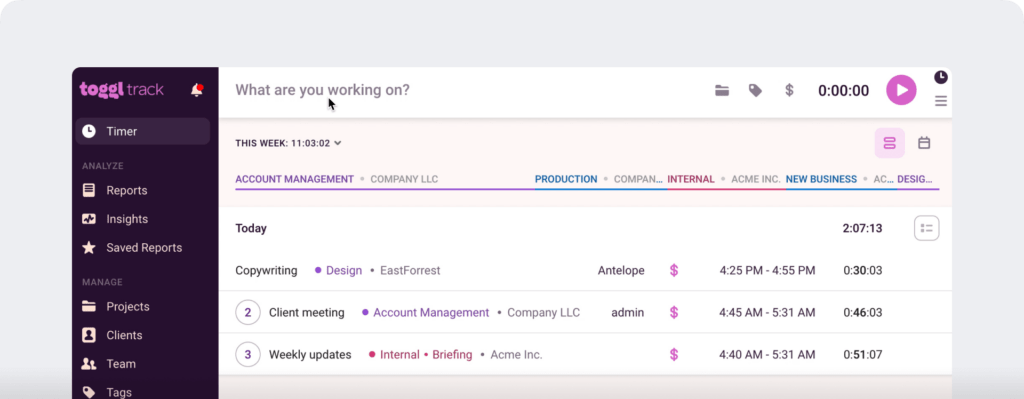
The automatic time tracking functionality can be adjusted within the app so that it gets triggered whenever you open a specific program or type a particular word.
Alternatively, you can use the manual option to track time.
Just click the ‘start’ button to begin tracking, and hit ‘stop’ when you’re done with your work. Toggl Track will then only track the time you record.
You can also manually set a Pomodoro timer to remind yourself to take breaks at set intervals.
Quick recap
RescueTime uses automatic time tracking by default, while Toggl Track has both manual and automatic time tracking options.
2. Project management
It’s possible that your team is working on multiple projects simultaneously and needs to forecast and track progress on a regular basis.
Let’s look at how these tools can help you with project and task management:
A. RescueTime
Unfortunately, RescueTime can’t track the time spent on each task or project.
Its tracking features can only tell you what websites or applications you’ve spent time on.
You can classify these applications under categories of:
- Business
- Design and composition
- Communication and scheduling
- Social media, etc.
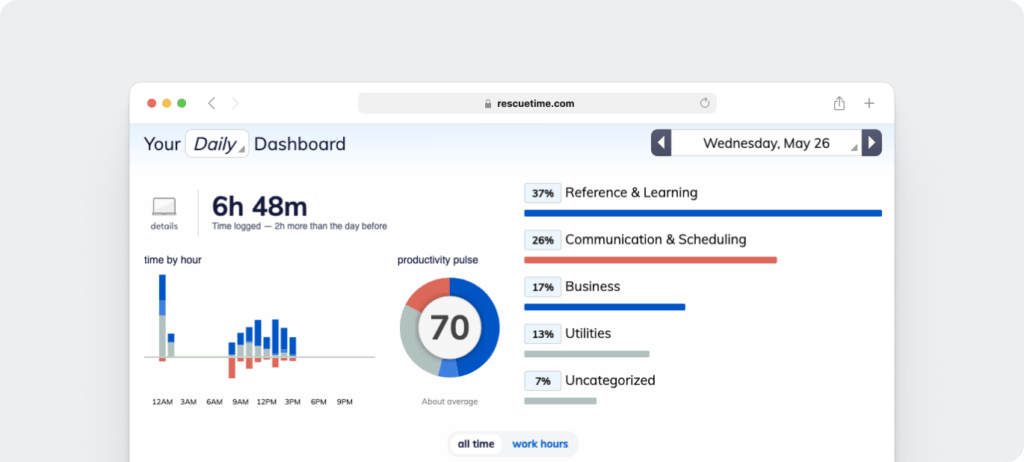
While you could calculate your time usage by adding your web and app activity for a particular project, it’s a cumbersome, time-consuming, and inaccurate process.
B. Toggl Track
Toggl Track’s project management dashboard gives you an overview of all your projects.
This management app lets you determine how much time you should work on a project and how you can meet your deadlines.
From your project dashboard, you can:
- Track time taken to complete that project.
- Determine productivity levels.
- Forecast time you’ll take to complete the project.
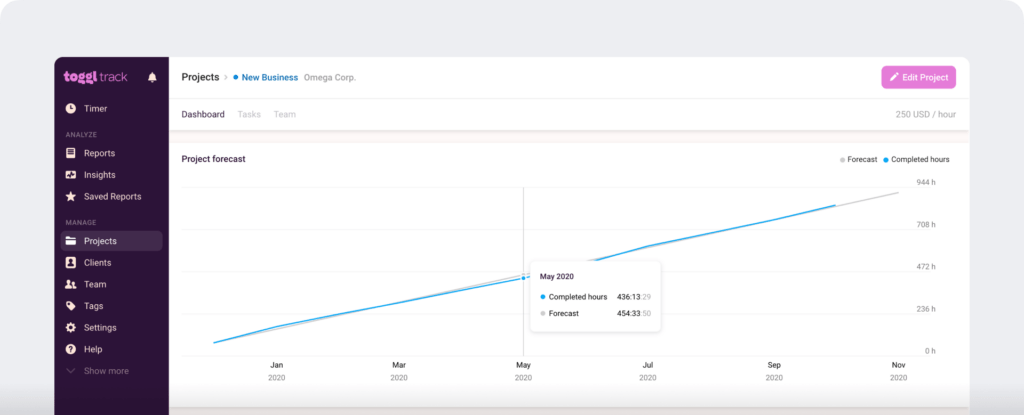
Quick recap
While RescueTime doesn’t have any project management features, Toggl Track has a project management dashboard that allows you to see how you’ve spent time on your projects.
3. Distraction management
These tracker app features can help you block or manage distractions such as social media, video streaming sites, etc.
Here’s how they work:
A. RescueTime
RescueTime uses a feature called FocusTime to block your productive work hours.

It works in customized time periods called ‘sessions.’
During these sessions, websites that are considered ‘distracting’ like Facebook are blocked, encouraging you to get back to work.
You can customize RescueTime to categorize the websites you visit as:
- Distracting
- Very Distracting
- Neutral
- Productive
- Very Productive
Depending on how you have blocked or whitelisted certain sites, you can set FocusTime mode across three strictness levels:
- Normal: Only sites categorized as very distracting are blocked.
- Intermediate: Blocks sites categorized as distracting and very distracting.
- Strict: Will block any site not categorized as productive.
However, to access this feature, you’ll have to upgrade to the premium plan ($12/month.)
B. Toggl Track
Toggl Track has an idle detection feature to help you stay productive.
This feature can detect when you’ve stepped away from your computer. It then displays a timer pop-up for the amount of time you have been idle or inactive.
You can also choose to delete the time you were distracted or mark the time as not working.

Quick recap
To help you stay productive, RescueTime enables you to block websites; and Toggl Track warns you of your inactive work hours.
4. Productivity reports
Productivity reports provide an analysis of your team’s performance over any period, both retrospectively and in real-time.
Let’s take a closer look at the productivity reports of each tracking tool:
A. RescueTime
With RescueTime, you can see how your employees perform as a team with their ‘Group Reports’ in the ‘Teams’ version of RescueTime.
Within the category of Group Reports, you can view:
- Summary reports: Get an overview of how your team spends its time.
- Categories reports: Determine the amount of time spent across categories.
- Key tools report: See an analysis of time spent in different work software.
- Daily highlights report: Access daily highlights of logged reports.
- Productivity report: Get a productivity score (between 0-100) and a breakdown of your time usage across each productivity rating.
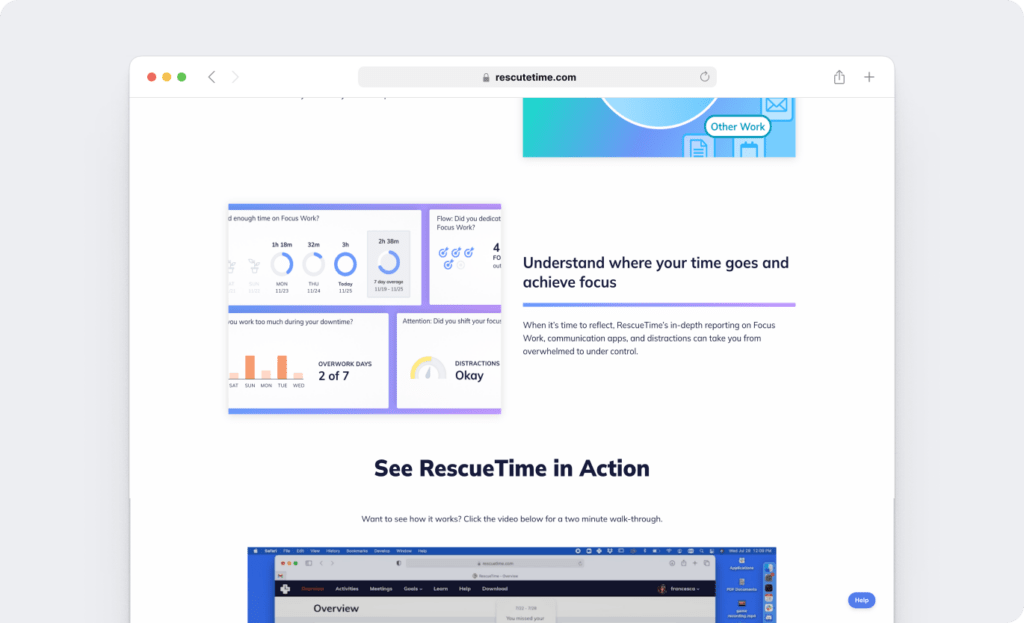
B. Toggl Track
Like RescueTime, Toggl Track’s productivity tracker can generate some insightful productivity reports.
Their reports are categorized as:
- Detailed report: Get individual time entries over any chosen date range and options to filter data by the project, task, client, etc.
- Summary report: See a broader view of tracked time using your billable hours, clocked time, etc., for various projects and tasks.
- Weekly report: Know the amount of time you’ve tracked over the last week.
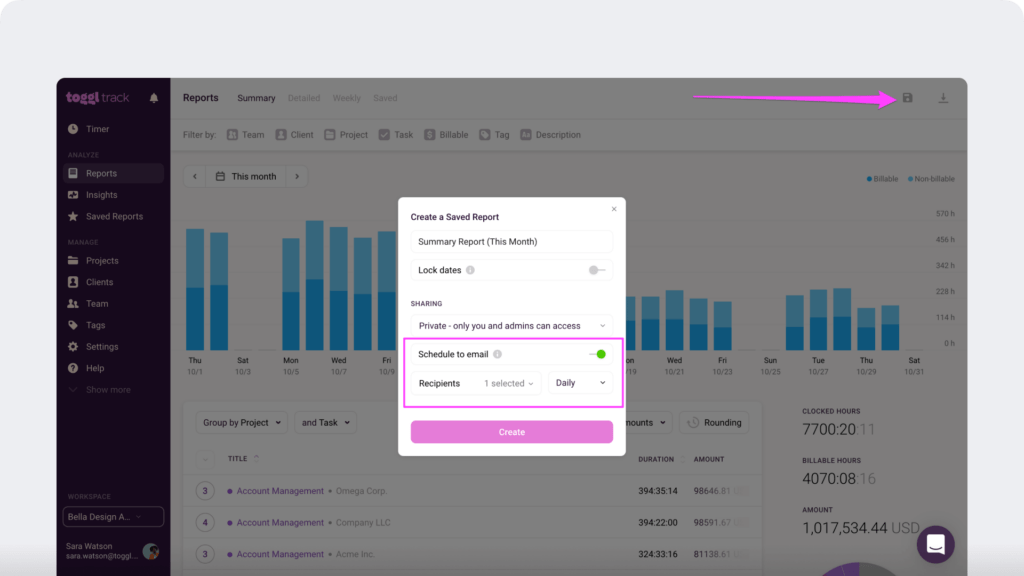
Quick recap
While both tools allow you to analyze how you spent your work, RescueTime’s productivity reports are much more detailed than that of Toggl Track.
5. Integrations
You need to sync data between various tools to avoid manually importing and exporting data between them.
Software integrations help you achieve this.
Let’s look at the integration options with RescueTime and Toggl Track:
A. RescueTime
RescueTime can be directly integrated with work tools such as:
- Slack: Auto-update Slack status based on your current activities.
- Office 365 Calendar: Put up a summary of your logged time and goal results on your calendar.
- Zapier: Connect hundreds of apps like GitHub and Todoist to streamline your workflow.
B. Toggl Track
Toggl Track’s browser extension for Google Chrome integrates with more than a hundred tools, including several CRM, expense tracking, and management tools.
Some key integrations include:
- Evernote: See the amount of time you take in writing notes on Evernote.
- Redmine: Get in-depth time tracking reports for your ongoing project work in Redmine.
- Zapier: Connect with Freshbooks, Harvest, QuickBooks, and many other apps by integrating Toggl with Zapier.
Quick recap
Both Toggl Track and RescueTime integrate with several tools to help you streamline your workflow. However, Toggl Track integrates with more applications than RescueTime.
6. Compatibility
Before you buy software, you have to see if it can run on your system.
Let’s see if RescueTime and Toggl track fulfill this requirement:
A. RescueTime
RescueTime is compatible with Mac, Windows, and Linux. It also has a Chrome browser extension and an app for a mobile device- both iOS and Android devices.
B. Toggl Track
Toggl Track is compatible with Linux, Windows, and Mac. It also has a Firefox and Chrome productivity extension and a mobile app for Android and iOS platforms.
Quick recap
Both RescueTime and Toggl Track support all major operating systems and have Chrome extensions.
7. Pricing
Before you buy any productivity tool, it’s important to weigh its cost against the value it’s going to provide for your business.
Let’s look at how pricing of the two tools:
A. RescueTime
While there’s a free plan available, it lacks some essential features.
RescueTime paid plans start at $12/month per user and offers a 14-day free trial (credit card required.) The paid plan includes everything from the free version and additional features that include distraction management and alerts.
B. Toggl Track
Toggl Track offers a free plan which supports unlimited projects for up to five members.
It has three paid plans and a 30-day free trial (credit card required), which include:
- Starter: $10/user per month – includes billable rates, time rounding, and time budgeting.
- Premium: $18/user per month – includes time tracking reminders, scheduled reporting, time audits, and project management.
- Enterprise: Price available on request – includes unlimited users, along with expert training and assistance.
Quick recap
While Toggl is more affordable than RescueTime, you’ll have to pay more to access features like time tracking reminders and project management.
A powerful alternative to RescueTime and Toggl
We’ve compared both RescueTime and Toggl Track on the features such as time tracking, project management, distraction management, reports, and more.
But there’s another tool that you should consider…
It’s called Time Doctor, and it does a lot more than just basic time tracking.
Used by employees of large companies as well as medium and small businesses, Time Doctor is an excellent option to track time and boost employee performance.
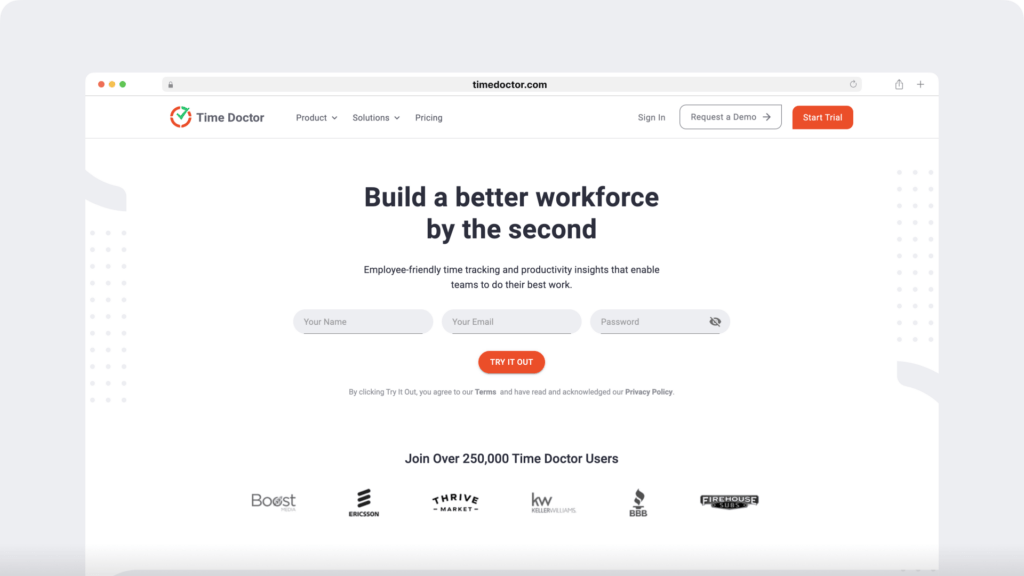
Here are its key features:
- User-friendly interface and easy time tracking in real-time on various projects.
- Spur employee productivity with insightful employee productivity reports.
- Customize the software to mark unproductive sites and applications.
- Integrate with other tools like Asana, Basecamp, Trello, Jira, etc.
- Both offline and online time tracking in the desktop app, and more.
Unlike Toggl and RescueTime, you can take periodic screenshots of your remote employees to ensure that they’re working.
With features to blur and delete screenshots containing sensitive information, you don’t have to worry about any privacy issues with Time Doctor. Time Doctor also has a strict data security policy.
You can also generate payroll in an instant to bill your clients and pay your remote team members.
But is Time Doctor expensive?
TimeDoctor is more affordable than Toggl and RescueTIme — its basic plan starts at $5.9/user per month.
You can also sign up for a 14-day free trial today (no credit card required) to try out Time Doctor’s powerful features.
Toggl Vs RescueTime: Final verdict
Both RescueTime and Toggl Track have their pros and cons.
RescueTime is a good option when you want to boost productivity.
The RescueTime alternative, Toggl Track, gives you more control over when you want to track your time.
However, if you want to track time and productivity with advanced and user-friendly features, you can opt for a powerful tool like Time Doctor.
Ultimately, choose the best tool for your business based on your budget and requirements.


